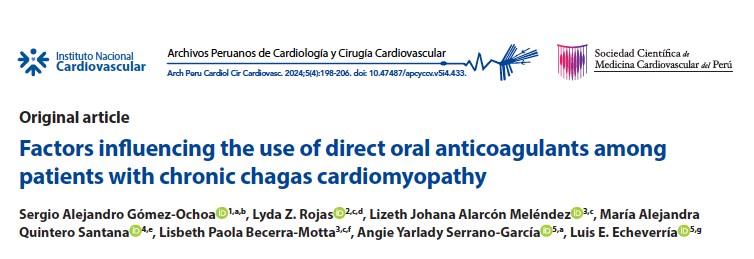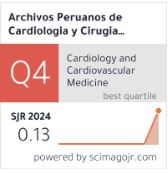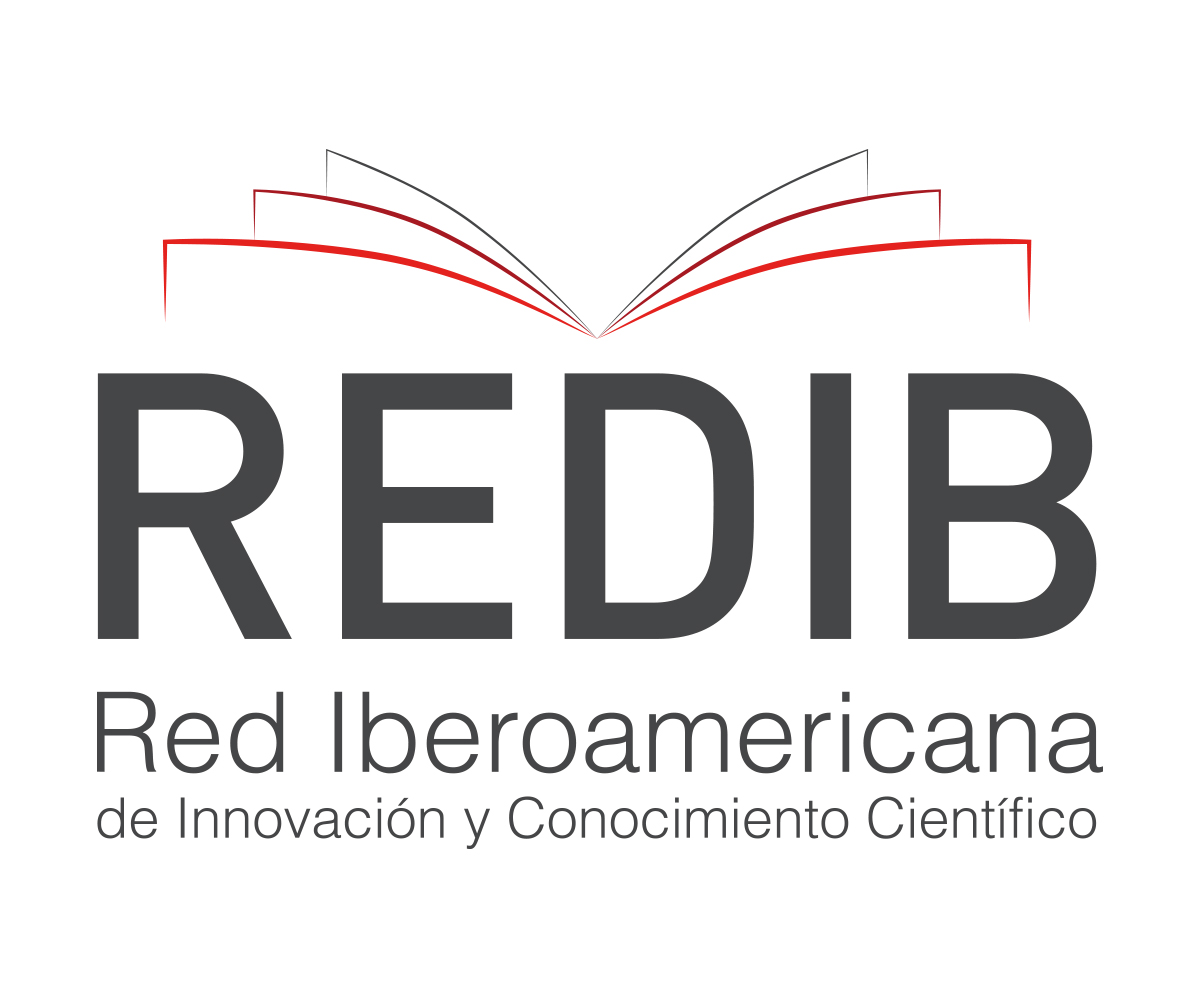Factors influencing the use of direct oral anticoagulants among patients with chronic chagas cardiomyopathy
DOI:
https://doi.org/10.47487/apcyccv.v5i4.433Palabras clave:
Chagas Disease, Chagas Cardiomyopathy, AnticoagulantsResumen
Objective. Chronic Chagas cardiomyopathy (CCC) carries a high risk of embolic events due to structural changes in the left ventricle and frequent conduction disorders. However, there is limited data on anticoagulant prescription patterns and factors influencing the use of direct oral anticoagulants (DOACs) in these patients. This study aims to characterize CCC patients based on the anticoagulant therapy received and identify factors associated with DOACs use. Materials and Methods. A cross-sectional study was conducted at a tertiary-level hospital in Colombia between 2019-2022. Multivariate logistic regression models were used to assess factors associated with anticoagulant therapy and DOACs use. Results. Among 224 CCC patients, 65.7% (n=153) were on anticoagulants, with DOACs being the most prescribed (53%). Notably, 35% of patients at high risk of stroke (CHA2DS2-VASc) were not receiving anticoagulants. Atrial fibrillation (OR 256.08; 95% CI 61.94-1058.72), ventricular aneurysms (OR 4.82; 95% CI 1.54-15.09), and reduced interventricular septal thickness (OR 0.75; 95% CI 0.60-0.92) were associated with anticoagulant use. DOACs were mainly prescribed for patients with atrial fibrillation (OR 13.29; 95% CI 2.47-71.56) and high bleeding risk (HAS-BLED ≥3, OR 11.36; 95% CI 1.15-112.11). Conclusions. A significant proportion of CCC patients were not receiving anticoagulants despite their high risk of stroke and embolic events. The use of anticoagulation was significantly associated with atrial fibrillation, the presence of ventricular aneurysms and reduced interventricular septal thickness. It is crucial to raise awareness among healthcare professionals in endemic areas to improve treatment.
Descargas
Referencias
Echeverria LE, Morillo CA. American Trypanosomiasis (Chagas Disease). Infect Dis Clin North Am. 2019;33:119-34. doi: 10.1016/j.idc.2018.10.015.
Requena-Méndez A, Aldasoro E, de Lazzari E, Sicuri E, Brown M, Moore DAJ, et al. Prevalence of Chagas disease in Latin-American migrants living in Europe: a systematic review and meta-analysis. PLoS Negl Trop Dis. 2015;9:e0003540. doi: 10.1371/journal.pntd.0003540.
Bonney KM, Luthringer DJ, Kim SA, Garg NJ, Engman DM. Pathology and Pathogenesis of Chagas Heart Disease. Annu Rev Pathol. 2019;14:421-47. doi: 10.1146/annurev-pathol-020117-043711.
Nunes MCP, Beaton A, Acquatella H, Bern C, Bolger AF, Echeverría LE, et al. Chagas Cardiomyopathy: An Update of Current Clinical Knowledge and Management: A Scientific Statement From the American Heart Association. Circulation. 2018;138:e169-209. doi: 10.1161/CIR.0000000000000599.
Shen L, Ramires F, Martinez F, Bodanese LC, Echeverría LE, Gómez EA, et al. Contemporary Characteristics and Outcomes in Chagasic Heart Failure Compared With Other Nonischemic and Ischemic Cardiomyopathy. Circ Heart Fail. 2017;10:e004361. doi: 10.1161/CIRCHEARTFAILURE.117.004361.
Lage TAR, Tupinambás JT, Pádua LB de, Ferreira M de O, Ferreira AC, Teixeira AL, et al. Stroke in Chagas disease: from pathophysiology to clinical practice. Rev Soc Bras Med Trop. 2022;55:e0575. doi: 10.1590/0037-8682-0575-2021.
Cardoso RN, Macedo FYB, Garcia MN, Garcia DC, Benjo AM, Aguilar D, et al. Chagas Cardiomyopathy is Associated With Higher Incidence of Stroke: A Meta-analysis of Observational Studies. J Card Fail. 2014;20:931-8. doi: 10.1016/j.cardfail.2014.09.003.
Lima-Costa MF, Matos DL, Ribeiro ALP. Chagas Disease Predicts 10-Year Stroke Mortality in Community-Dwelling Elderly. Stroke. 2010;41:2477-82. doi: 10.1161/STROKEAHA.110.588061.
Cerqueira-Silva T, Gonçalves BM, Pereira CB, Porto LM, Marques ME, Santos LS, et al. Chagas disease is an independent predictor of stroke and death in a cohort of heart failure patients. Int J Stroke. 2022;17:180-8. doi: 10.1177/17474930211006284.
Hindricks G, Potpara T, Dagres N, Arbelo E, Bax JJ, Blomström-Lundqvist C, et al. 2020 ESC Guidelines for the diagnosis and management of atrial fibrillation developed in collaboration with the European Association for Cardio-Thoracic Surgery (EACTS): The Task Force for the diagnosis and management of atrial fibrillation of the European Society of Cardiology (ESC) Developed with the special contribution of the European Heart Rhythm Association (EHRA) of the ESC. Eur Heart J. 2021;42:373-498. doi: 10.1093/eurheartj/ehaa612.
Nunes MCP, Barbosa MM, Ribeiro ALP, Barbosa FBL, Rocha MOC. Ischemic cerebrovascular events in patients with Chagas cardiomyopathy: a prospective follow-up study. J Neurol Sci. 2009;278:96-101. doi: 10.1016/j.jns.2008.12.015.
Sousa AS de, Xavier SS, Freitas GR de, Hasslocher-Moreno A. Prevention strategies of cardioembolic ischemic stroke in Chagas’ disease. Arq Bras Cardiol. 2008;91:306-10. doi: 10.1590/s0066-782x2008001700004.
Bestetti R. Stroke in a hospital-derived cohort of patients with chronic Chagas’ disease. Acta Cardiol. 2000;55:33-8. doi: 10.2143/AC.55.1.2005715.
Ianni BM, Mady C, Arteaga E, Fernandes F. [Cardiovascular diseases observed during follow-up of a group of patients with undetermined form of Chagas’ disease]. Arq Bras Cardiol. 1998;71:21-4. doi: 10.1590/s0066-782x1998000700005.
Arteaga-Fernández E, Barretto AC, Ianni BM, Mady C, Lopes EA, Vianna C de B, et al. [Cardiac thrombosis and embolism in patients having died of chronic Chagas cardiopathy]. Arq Bras Cardiol. 1989;52:189-92.
Aras R, da Matta JAM, Mota G, Gomes I, Melo A. Cerebral infarction in autopsies of chagasic patients with heart failure. Arq Bras Cardiol. 2003;81:414-6, 411-3. doi: 10.1590/s0066-782x2003001200008.
Cardoso R, Garcia D, Fernandes G, He L, Lichtenberger P, Viles-Gonzalez J, et al. The Prevalence of Atrial Fibrillation and Conduction Abnormalities in Chagas’ Disease: A Meta-Analysis: ECG Findings in Chagas’ Disease. J Cardiovasc Electrophysiol. 2016;27:161-9. doi: 10.1111/jce.12845.
Rojas LZ, Glisic M, Pletsch-Borba L, Echeverría LE, Bramer WM, Bano A, et al. Electrocardiographic abnormalities in Chagas disease in the general population: A systematic review and meta-analysis. PLoS Negl Trop Dis. 2018;12:e0006567. doi: 10.1371/journal.pntd.0006567.
Herrera RN, Díaz de Amaya EI, Pérez Aguilar RC, Joo Turoni C, Marañón R, Berman SG, et al. Inflammatory and prothrombotic activation with conserved endothelial function in patients with chronic, asymptomatic Chagas disease. Clin Appl Thromb Hemost. 2011;17:502-7. doi: 10.1177/1076029610375814.
Echeverría LE, Rojas LZ, Gómez-Ochoa SA. Coagulation disorders in Chagas disease: A pathophysiological systematic review and meta-analysis. Thromb Res. 2021;201:73-83. doi: 10.1016/j.thromres.2021.02.025.
Stimpert KK, Montgomery SP. Physician Awareness of Chagas Disease, USA. Emerg Infect Dis. 2010;16:871-2. doi: 10.3201/eid1605.091440.
Stigler Granados P, Pacheco GJ, Núñez Patlán E, Betancourt J, Fulton L. Assessing the effectiveness of Chagas disease education for healthcare providers in the United States. BMC Infect Dis. 2020;20:743. doi: 10.1186/s12879-020-05474-w.
Las Casas AA, Las Casas AA, Borges MAF, Melo-Souza SE. Rivaroxaban for treatment of intraventricular thrombus in Chagas disease. J Cardiol Cases. 2015;13:75-7. doi: 10.1016/j.jccase.2015.10.010.
Kido K, Ghaffar YA, Lee JC, Bianco C, Shimizu M, Shiga T, et al. Meta-analysis comparing direct oral anticoagulants versus vitamin K antagonists in patients with left ventricular thrombus. PLoS One. 2021;16:e0252549. doi: 10.1371/journal.pone.0252549.
Dalia T, Lahan S, Ranka S, Goyal A, Zoubek S, Gupta K, et al. Warfarin versus direct oral anticoagulants for treating left ventricular thrombus: a systematic review and meta-analysis. Thromb J. 2021;19:7. doi: 10.1186/s12959-021-00259-w.
Bassand J-P, Virdone S, Badoz M, Verheugt FWA, Camm AJ, Cools F, et al. Bleeding and related mortality with NOACs and VKAs in newly diagnosed atrial fibrillation: results from the GARFIELD-AF registry. Blood Adv. 2021;5:1081-91. doi: 10.1182/bloodadvances.2020003560.
Kundu A, Sardar P, Chatterjee S, Aronow WS, Owan T, Ryan JJ. Minimizing the Risk of Bleeding with NOACs in the Elderly. Drugs Aging. 2016;33:491-500. doi: 10.1007/s40266-016-0376-z.
Dalmau Llorca MR, Aguilar Martín C, Carrasco-Querol N, Hernández Rojas Z, Forcadell Drago E, Rodríguez Cumplido D, et al. Gender and Socioeconomic Inequality in the Prescription of Direct Oral Anticoagulants in Patients with Non-Valvular Atrial Fibrillation in Primary Care in Catalonia (Fantas-TIC Study). Int J Environ Res Public Health. 2021;18:10993. doi: 10.3390/ijerph182010993.
Zhang Y-S, Chen J-H, Mei T, Li S, Lu Y-M. Efficacy and safety of DOACs in patients with peripheral arterial disease: A systematic review and meta-analysis. Vascular. 2021;29:846-55. doi: 10.1177/1708538120987935.
Siegal DM, Anand SS. Considerations for use of direct oral anticoagulants in arterial disease. Res Pract Thromb Haemost. 2021;5:10.1002/rth2.12502. doi: 10.1002/rth2.12502.

Descargas
Publicado
Número
Sección
Licencia
Derechos de autor 2024 La revista es titular de la primera publicación, luego el autor dando crédito a la primera publicación.

Esta obra está bajo una licencia internacional Creative Commons Atribución 4.0.

















